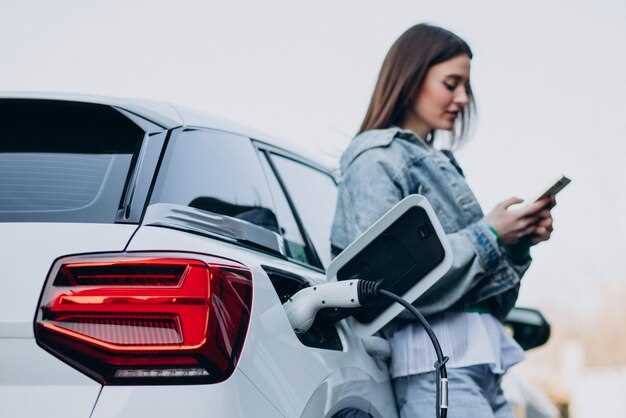How to Maximize Your Hybrid Car’s Fuel Economy

In today’s world, where environmental concerns are escalating and fuel prices are on the rise, owning a hybrid car presents a unique opportunity to enhance both efficiency and sustainability. These vehicles utilize a combination of gasoline and electric power to achieve remarkable fuel economy figures. However, to truly capitalize on the benefits of a hybrid vehicle, it is crucial to adopt specific driving habits and maintenance practices.
The fuel economy of hybrid cars can significantly vary based on driving style, road conditions, and vehicle upkeep. By understanding the mechanics of hybrid engines and implementing strategies tailored to their operation, drivers can unlock the potential for even greater savings at the pump. From managing speed and acceleration to optimizing tire pressure and utilizing regenerative braking systems, there are numerous ways to get the most out of your vehicle’s fuel efficiency.
Moreover, maintaining your hybrid car through regular check-ups and timely repairs is essential for ensuring that the vehicle operates at peak efficiency. Neglecting simple maintenance tasks can lead to increased fuel consumption and diminished performance. By addressing these elements, you will not only improve your car’s fuel economy but also extend its lifespan, contributing to a greener planet.
In the following sections, we will explore practical tips and methods that hybrid car owners can implement to maximize their vehicle’s fuel economy. By adopting these techniques, you can enjoy the financial benefits of reduced fuel costs while also making a positive impact on the environment.
Optimize Your Driving Habits for Better Mileage

To enhance the fuel efficiency of your hybrid vehicle, it is crucial to adopt effective driving habits. These adjustments can make a significant difference in your mileage, ultimately saving you time and money at the pump.
1. Accelerate Gradually: Rapid acceleration consumes more fuel. Instead, apply gentle pressure on the accelerator and allow your car to gain speed smoothly. This practice not only enhances fuel economy but also prolongs the life of various components, such as the transmission and brakes.
2. Maintain a Steady Speed: Utilizing cruise control on highways can help maintain a consistent speed. Fluctuating speeds lead to unnecessary fuel consumption, so aim to keep your speed steady wherever conditions allow.
3. Anticipate Traffic Lights: By observing traffic patterns, you can anticipate stops and starts. Gradually decelerating before a red light or stop sign can significantly reduce fuel use, allowing your hybrid’s regenerative braking system to recharge the battery.
4. Limit Idling: Extended idling consumes fuel without providing any mileage. If you anticipate being stopped for more than a minute, it’s advisable to turn off the engine, especially in hybrid vehicles where restarting is less taxing.
5. Reduce Aggressive Driving: Engaging in aggressive maneuvers such as abrupt lane changes, hard braking, and rapid acceleration can severely impact your fuel efficiency. Driving calmly and responsibly benefits both your mileage and safety.
6. Use Eco Mode: Many hybrid cars come with an eco-driving mode that optimizes engine performance for better fuel efficiency. Activating this feature can facilitate smoother acceleration and optimize power usage under various driving conditions.
7. Plan Efficient Routes: Utilize GPS navigation systems to identify the most efficient routes that minimize congestion and maximize highway driving. Shorter, stop-and-go routes often lead to higher fuel consumption.
8. Monitor Your Speed: Keeping your speed at or just under the speed limit can improve your mileage. Generally, fuel efficiency decreases significantly at speeds above 50 miles per hour. Maintaining a moderate speed can yield substantial fuel savings.
By adopting these driving habits, you can significantly enhance the fuel economy of your hybrid car, contributing positively to both your budget and the environment.
Maintain Your Hybrid Car Regularly to Improve Performance
Regular maintenance of your hybrid car is crucial for optimizing fuel economy and ensuring that it operates at peak performance. Hybrid vehicles have unique components, such as the electric motor and battery system, which require specific attention. Here, we outline key maintenance practices that can lead to better fuel efficiency.
| Maintenance Task | Frequency | Benefits |
|---|---|---|
| Oil Changes | Every 5,000-7,500 miles | Reduces engine friction and improves efficiency. |
| Tire Inspection and Rotation | Every 5,000 miles | Ensures optimal traction and fuel efficiency. |
| Brake System Check | Every 15,000 miles or as needed | Prevents excessive wear on the braking system, enhancing efficiency. |
| Battery Health Assessment | At least once a year | Detects potential issues early, extending battery life and improving performance. |
| Coolant Level Check | Every 30,000 miles | Maintains optimal operating temperatures, ensuring efficient engine performance. |
| Air Filter Replacement | Every 15,000-30,000 miles | Improves airflow to the engine, enhancing fuel economy. |
In addition to these tasks, keeping your hybrid car clean and regularly inspecting its exterior and interior components can contribute to better performance. Addressing issues promptly and following the manufacturer’s recommended maintenance schedule will ensure that your hybrid vehicle not only delivers fuel efficiency but also lasts longer on the road.
Select the Right Tires for Enhanced Fuel Efficiency
Selecting the appropriate tires for your hybrid vehicle can significantly contribute to maximizing fuel economy. Tires impact rolling resistance, which directly affects how efficiently your car consumes fuel. Here are key considerations for choosing tires that enhance fuel efficiency:
- Low Rolling Resistance: Opt for tires specifically designed for low rolling resistance. These tires require less energy to roll, thereby improving fuel economy. Many manufacturers offer eco-friendly tires that emphasize this feature.
- Tire Size: Choose the size recommended by your vehicle manufacturer. Larger tires may look appealing but often increase rolling resistance and decrease fuel efficiency. Maintaining the correct size ensures optimal performance.
- Tread Design: Look for tires with a streamlined tread pattern. Tires with fewer and shallower grooves can create less aerodynamic drag, enhancing fuel economy. All-season tires can be a great compromise for urban driving.
- Proper Inflation: Ensure your tires are always properly inflated. Under-inflated tires increase rolling resistance and can lead to increased fuel consumption. Regularly check tire pressure and maintain it according to manufacturer specifications.
- Weight Considerations: Lighter tires produce less rolling resistance. When choosing your tires, consider materials and construction techniques that reduce unnecessary weight while maintaining safety and performance.
In conclusion, the right tires are a critical component of achieving optimal fuel efficiency in your hybrid car. By selecting low rolling resistance tires, adhering to manufacturer specifications for size, and ensuring proper maintenance, you can enhance your vehicle’s fuel economy effectively.
Utilize Regenerative Braking to Save Energy
One of the most significant advantages of hybrid vehicles is their ability to harness energy during braking through a system known as regenerative braking. This technology transforms the kinetic energy generated when slowing down into electrical energy, which is then stored in the vehicle’s battery for later use. By incorporating regenerative braking into your driving habits, you can greatly enhance fuel efficiency and extend the life of your battery.
To effectively utilize regenerative braking, focus on smooth deceleration. Instead of applying the brakes abruptly, gradually ease off the accelerator pedal to allow the system to capture as much energy as possible. This gentle approach not only maximizes energy recovery but also helps maintain vehicle control, resulting in a safer driving experience.
Additionally, familiarize yourself with the braking thresholds of your hybrid. In many models, the regenerative braking system activates when you lightly brake, while conventional brakes are employed for more decisive stops. Recognizing when to shift your braking style can increase the amount of energy recaptured during drives.
Another key practice is to anticipate stops. Keep an eye on traffic signals and road conditions ahead, allowing you to coast to a stop when possible. This not only minimizes brake use but also maximizes the opportunity for regenerative braking, thereby enhancing your vehicle’s overall efficiency.
Lastly, regularly monitor your vehicle’s energy display, if available. Many hybrids come equipped with dashboards that indicate when regenerative braking is actively recovering energy. Paying attention to this information can motivate you to change habits and improve your driving efficiency.
By integrating these techniques into your routine, you can fully leverage regenerative braking technology, ultimately saving energy and contributing to a more sustainable driving experience.
Reduce Weight and Drag to Enhance Fuel Usage
Maximizing fuel economy in a hybrid car requires a focus on reducing both weight and aerodynamic drag. Each kilogram removed from the vehicle translates directly to improved efficiency, particularly in hybrids where the synergy between the electric motor and gasoline engine is crucial. Begin by assessing the cargo you carry; unnecessary items should be removed to lighten the load. Regularly clear out the trunk and cabin to ensure no excess weight hinders performance.
Upgrading to lightweight materials can also contribute significantly to weight reduction. Consider replacing standard components, such as wheels or battery casing, with lighter alternatives. Additionally, choosing a hybrid model that utilizes advanced materials like aluminum or carbon fiber during your purchase can further enhance overall efficiency.
Aerodynamic drag is another critical factor impacting fuel economy. Every vehicle generates drag, which increases fuel consumption, especially at higher speeds. Modifying your driving style can minimize drag; try to maintain steady speeds and avoid rapid acceleration. Keeping windows closed at higher speeds is crucial, as open windows create turbulence that increases drag.
Further enhancements can include adding aerodynamic modifications, such as a rear spoiler, side skirts, or wind deflectors. These accessories can help smooth airflow over the vehicle, reducing resistance. Maintaining tire pressure at the recommended levels also plays a vital role; properly inflated tires reduce rolling resistance, which indirectly influences aerodynamic efficiency.
Lastly, minimizing the use of roof racks or external cargo carriers when not in use will lead to significant drag reduction. The sleek lines of your hybrid are designed for efficiency; adding bulky accessories disrupts airflow. By strategically addressing both weight and drag, you can significantly enhance the fuel economy of your hybrid vehicle.
Plan Routes Thoughtfully to Minimize Fuel Consumption
To optimize fuel economy in your hybrid vehicle, planning your routes effectively is essential. The manner in which you navigate can significantly impact fuel consumption. By employing a few strategic approaches, you can reduce unnecessary mileage and minimize energy expenditure.
Utilize Navigation Technology: Modern GPS systems and apps offer real-time traffic updates. Take advantage of these tools to avoid congested areas that may slow your speed and increase fuel consumption. By choosing less congested routes, you can maintain a steady pace, which hybrid cars are designed to optimize.
Choose Shorter Distances: When planning trips, consider selecting routes that are not only shorter in distance but also involve fewer stops. Frequent braking and accelerating in stop-and-go traffic consume more fuel. If possible, incorporate routes with fewer traffic lights or intersections to facilitate smoother driving.
Factor in Elevation Changes: Terrain can have a notable effect on fuel efficiency. Routes with steep inclines require more energy from your hybrid vehicle, leading to higher fuel usage. Use elevation maps to identify flat or gently sloping routes that can assist in maintaining optimal fuel economy.
Time Your Trips Wisely: Traveling during off-peak hours can significantly reduce your time spent in traffic. Identifying less busy times for your travels allows for a more efficient route, without the need to waste fuel idling in congestion.
Combine Errands: Instead of making multiple trips, combine errands into a single journey. This reduces the frequency of cold starts, which consume extra fuel. By grouping tasks, you can plan a route that flows seamlessly from one destination to another.
Regularly Update Your Route Preferences: Depending on changing traffic patterns and construction, frequently reassess your preferred routes. Updates to road conditions can reveal new, more efficient paths that save both time and fuel, enhancing your driving experience.
By thoughtfully planning your routes, you can significantly decrease fuel consumption in your hybrid vehicle, leading to both financial savings and a reduced environmental impact.

